
Understanding the Pharming Definition: A Guide to Cybersecurity Risks
What is Pharming Attack? Understanding its Risks and Impact
Cybersecurity is always changing, and hackers are getting smarter with new ways to trick people online. One of these newer threats is called pharming a mix of the words “phishing” and “farming.” It’s a sneaky method used to steal personal information by sending users to fake websites that look like a legitimate website.
The big difference between pharming and phishing is that pharming doesn’t need the user to do anything, like click a link or open an email. Instead, hackers install harmful code on your device or network, which quietly redirects you to a fake site. Once there, any data you enter like passwords, bank info, or login details can be stolen.
In this article, we’ll explain how pharming works, go over the different types of attacks, and share tips on how to protect your business or personal data from a phishing attack. Keep reading to stay safe and understand why pharming is a serious threat in today’s digital world.
What is Pharming?
Pharming is a type of cyberattack were criminals trick internet users. They redirect users to fake sites, also called a fake or spoofed website. These fake sites are built to steal important information. The goal is to capture personally identifiable information (PII), like login details, passwords, social security numbers, and account numbers. Often, the aim of pharmers is identity theft, which can harm both individuals and businesses.
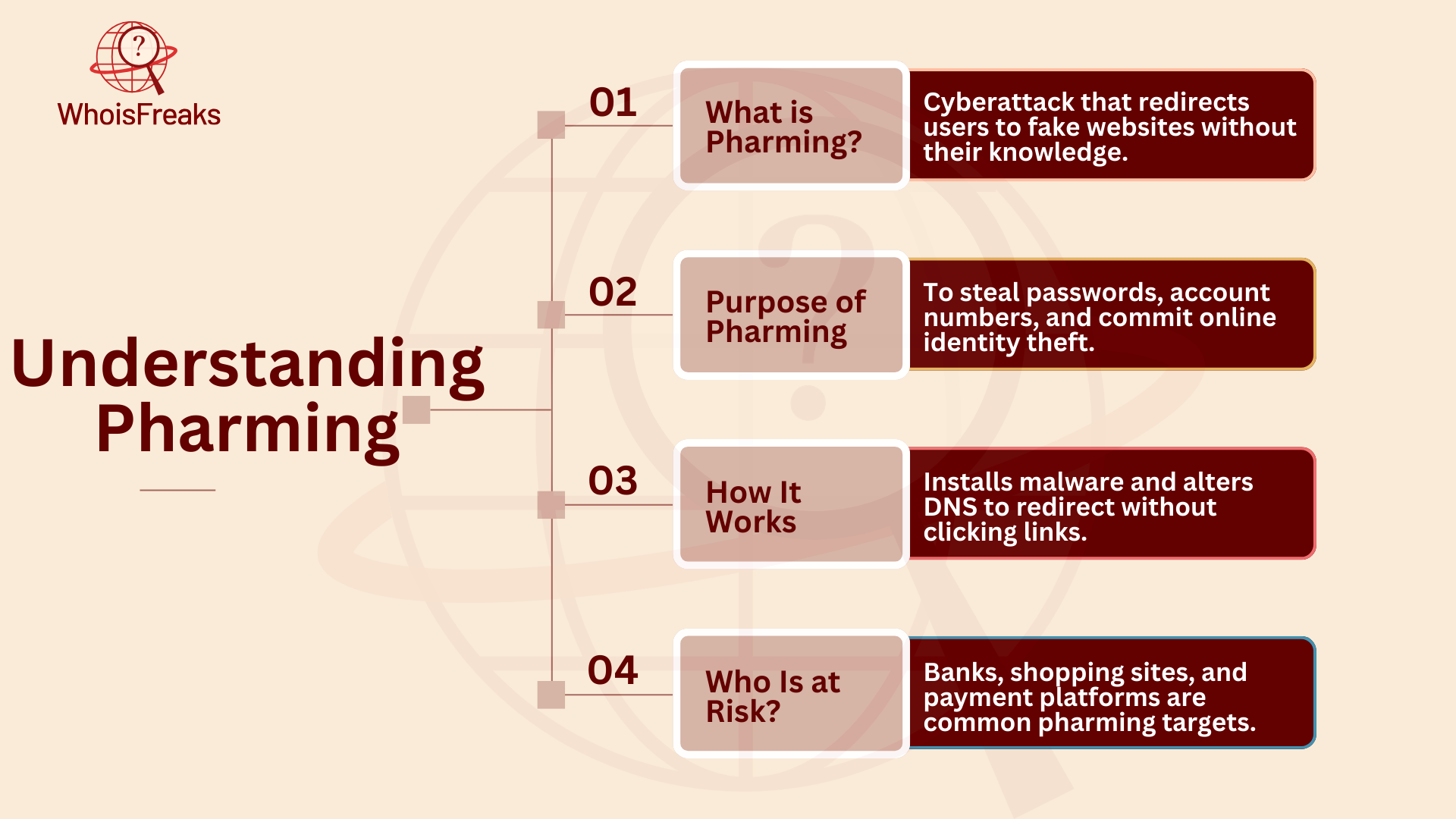
Pharming attacks usually target websites in the financial sector. These include banks, online payment platforms, and e-commerce sites. These sites handle sensitive transactions, making them a big target. The attackers may also try to install malicious software as part of the pharming malware on the victim’s computer. This malware gives them more access to data and can cause long-lasting harm. Pharmers take advantage of the trust users have in real websites, making pharming a growing threat to online safety.
How does Pharming Works
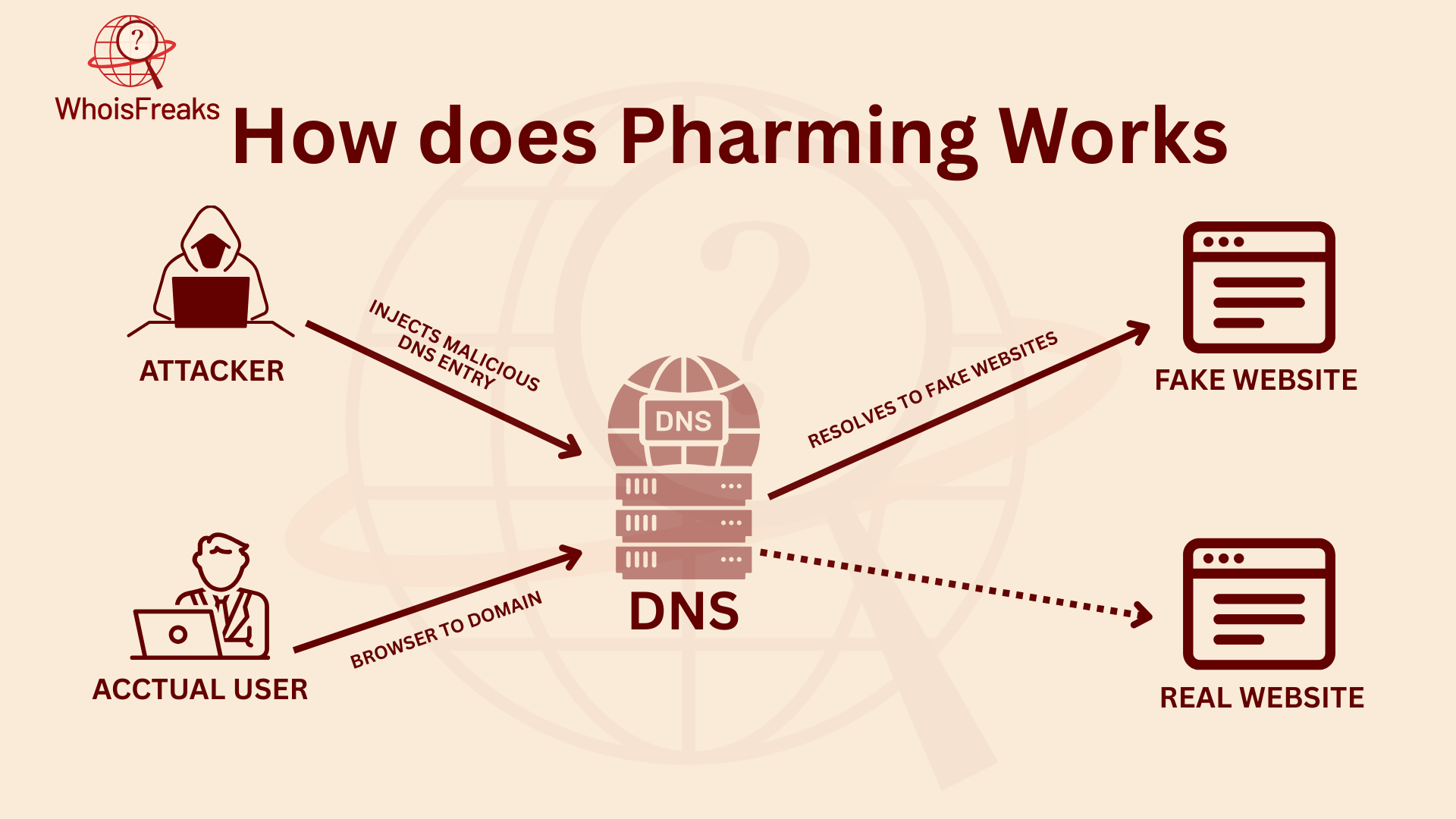
Pharming is a type of scam that tricks internet users into visiting fake websites. These fake sites are made to steal personal and financial details like login information, credit card numbers, and social security numbers. Attackers use different methods to carry out pharming attacks. They take advantage of weak points in the user’s computer, network, or DNS settings to make users go to these malicious sites. Here are some common methods used in pharming:
1. Malware Infection
Malware infection is a big part of pharming. Bad programs like viruses, Trojans, and keyloggers can infect a user’s computer or network. These programs can change DNS settings or mess with the host file through DNS poisoning. This sends users to fake websites without them knowing. Once there, attackers steal sensitive info like passwords or credit card numbers. This can lead to identity theft or money fraud.
2. DNS Cache Poisoning
DNS cache poisoning is another way hackers attack. The Domain Name System (DNS) helps turn website names into IP addresses. Attackers can poison the DNS cache by messing with the mapping between website names and IP addresses. This makes users go to fake sites instead of the reputable DNS servers. These fake sites are designed to steal sensitive info like login details or credit card numbers.
3. Host File Modification
Host file modification is another technique used by attackers. The host file is a local file on a computer that links website names to IP addresses. Attackers can change this file to alter DNS settings and send users to fake websites instead of real ones. Sometimes, this change happens in a local network, letting attackers' control where users go when they browse the web.
4. Rogue DNS Servers
Rogue DNS servers are another trick used in pharming. Attackers can set up fake DNS servers or take control of real ones. When users try to visit a real website, they are sent to a fake one instead. These fake servers give wrong IP addresses, leading users to websites that steal personal and financial info. Attackers take advantage of users trusting real DNS servers to carry out these attacks and steal sensitive data by attackers exploit vulnerabilities.
Once users are redirected to fraudulent websites, they’re often prompted to submit sensitive information that the attackers then capture. The attackers exploit this information for various malicious purposes, such as identity theft, financial fraud, or unauthorized access to financial data.
Types of Pharming Attacks
Pharming attacks can be broadly categorized into two main types, each with its unique characteristics and methods of execution. Understanding each type helps to devise effective countermeasures:
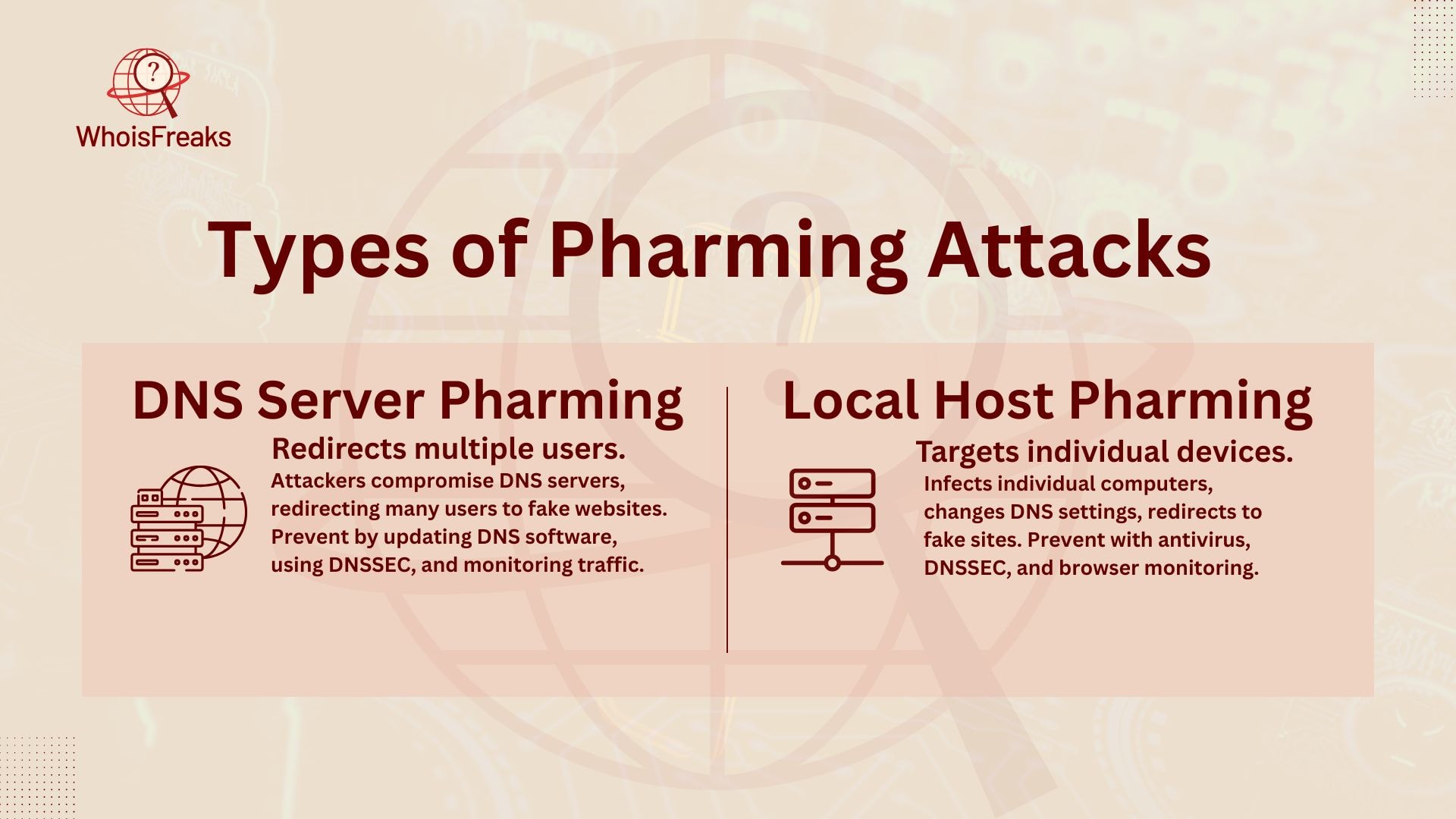
1. DNS Server Pharming:
DNS Server Pharming is a type of attack that targets DNS servers. Attackers use weaknesses in DNS software to send users to fake websites. These fake sites replace the real ones. Since DNS servers handle requests for many users, this can cause big problems for multiple users. If attackers take control, many users could be affected.
To stop these attacks, we can take a few steps. First, keep DNS software updated. This fixes known problems. Next, use DNSSEC (DNS Security Extensions) for extra protection. It stops changes that shouldn’t happen. Lastly, watch for unusual traffic. This helps find threats early and stop them.
2. Local Host Pharming:
Local Host Pharming is a type of attack. It uses weaknesses in DNS software. Attackers target DNS servers to send users to fake websites. These fake sites replace real ones. This can cause big problems for users. It messes up requests and sends people to fraudulent sites. When attackers control the DNS system, they can cause a lot of harm.
To protect against these attacks, a few steps can help. Using DNSSEC (DNS Security Extensions) adds extra security. It stops any unauthorized changes to DNS settings. Also, by monitoring your web browser and watching traffic patterns, threats can be spotted early. This helps stop attacks before they cause damage.
Both types of pharming attacks aim to deceive users and capture sensitive information, but they differ in their approach and impact. Awareness of these distinctions is crucial for both individual users and organizations.
Impact of Pharming
Pharming attacks can have serious consequences for both individuals and organizations. These attacks can lead to financial losses and the theft of personal information, putting users and businesses at great risk.
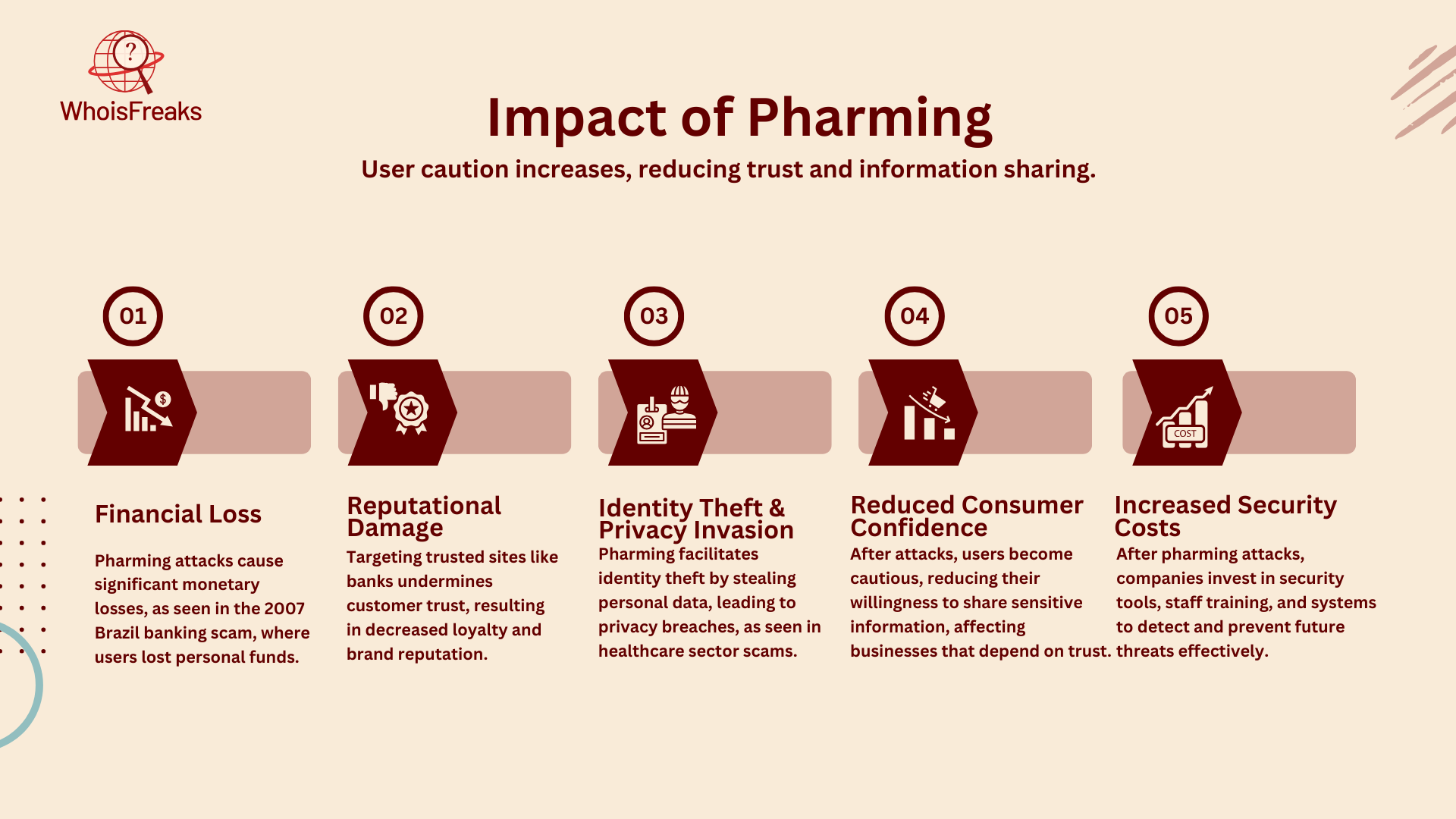
1. Financial Loss
Pharming attacks can cause big money losses. In 2007, a pharming attack hit major banks in Brazil. Cyber criminals tricked users into visiting fake bank sites. Personal and banking info was at risk. Many people lost a lot of money. This shows how serious the financial impact can be.
2. Reputational Damage
Pharming attacks can damage a company’s reputation. Trusted sites like banks are often the target. When this happens, customers feel unsafe. This erodes trust and harms the brand. Customers start to question the safety of the site. Companies lose loyalty and business success as a result.
3. Identity Theft and Privacy Invasion
Pharming can lead to identity theft and privacy issues. In 2014, pharming scams targeted healthcare workers. Employees were tricked into using fake login pages. Attackers stole credentials and accessed private patient info. This caused serious identity theft problems. It shows the risks when personal data is stolen.
4. Reduced Consumer Confidence
Pharming attacks have made people more careful online. Many now hesitate to share personal or financial info. This affects businesses that rely on online services. They have to rethink security measures to earn back trust.
5. Increased Security Costs
To fight pharming attacks, companies need better security. They invest in cyber tools to find and stop these attacks. After DNS pharming hits, some banks spent more on anti-pharming tools. They also train employees to spot threats. This shows how much companies must spend to protect customers.
Signs of a Pharming Attack
Recognizing the signs of a pharming attack can be difficult, but there are several red flags that you can look out for:
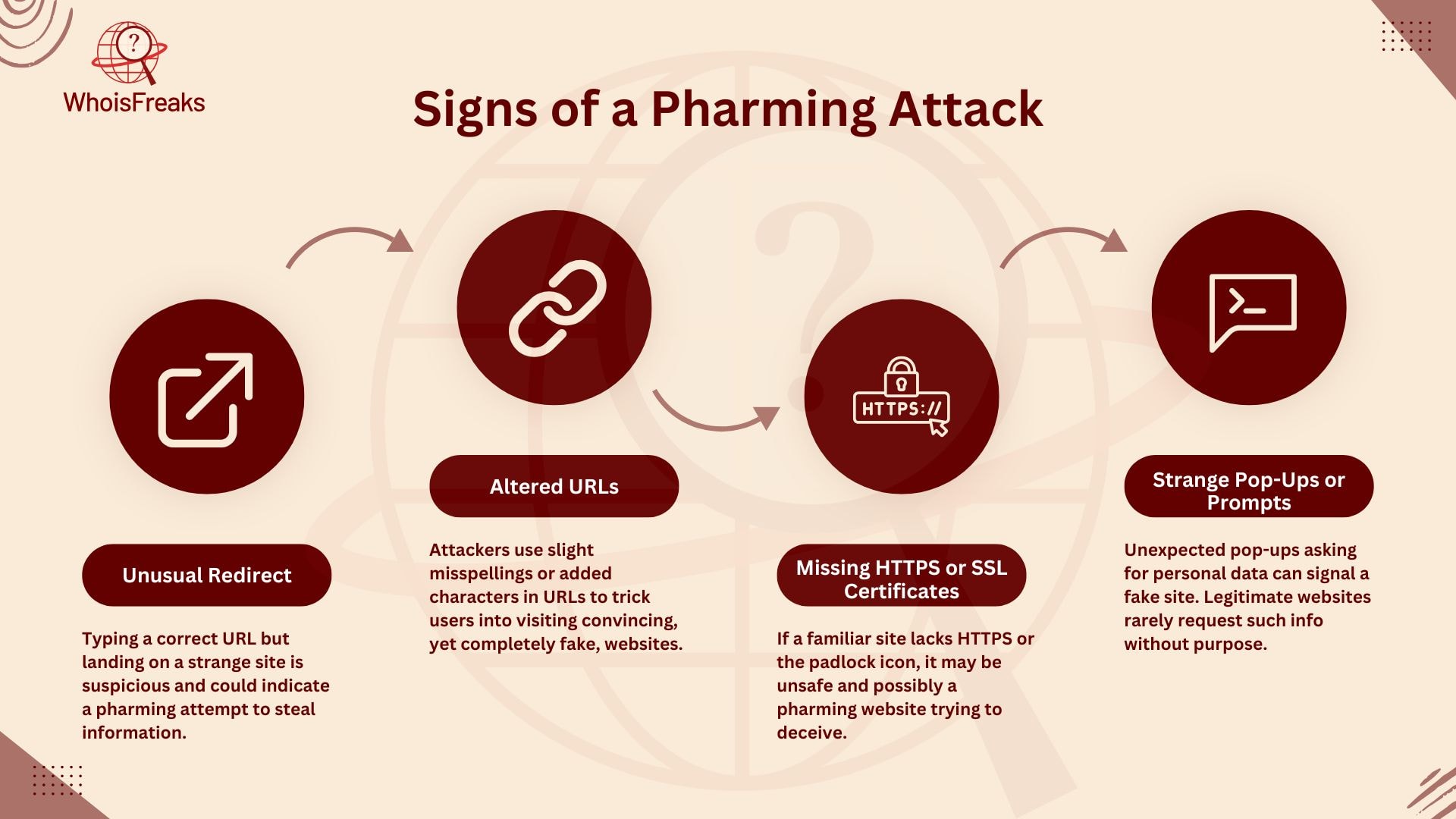
1. Unusual Redirect
One sign of a pharming attack is an unusual redirect. If you type a familiar URL but are sent to a different site, it could be an attack. This should be a red flag, as it may lead to fake sites trying to steal your info.
2. Altered URLs
Pharming websites often look like real ones. Attackers may change the URL by adding extra characters or misspelling words. These small changes can trick you into visiting a fake site that looks real.
3. Missing HTTPS or SSL Certificates
Real websites, especially those with sensitive data like bank info, use HTTPS. If you see a familiar site without HTTPS or a padlock icon, it might be a fake site. Missing SSL certificates are a warning that the site is not safe.
4. Strange Pop-Ups or Prompts
Pharming sites might show strange pop-ups or prompts asking for personal details. These are not normal for real sites. Be careful when a site asks for your info, especially if it seems unnecessary. This could be a trick to steal your data.
By watching out for these signs, you can avoid falling for a pharming attack.
Pharming vs. Phishing
| Aspect | Phishing | Pharming |
|---|---|---|
| Definition | Fraudulent emails trick users into visiting fake websites to steal personal info. | A type of phishing where hackers install malicious code on your device to redirect you to fake websites. |
| How it works | Cybercriminals send emails with fake links asking for personal details. | Hackers install malicious code to automatically redirect you to fake sites without needing a click. |
| Requires user action | Yes, the user clicks a link in an email, text, or social media message. | No, it happens automatically without user interaction. |
| Targeted methods | Emails, social media, or text messages that ask for sensitive info. | Malicious code installed on the device or server redirects you to fake websites. |
| Danger level | Less dangerous because it relies on user action. | More dangerous as it can affect many users without them knowing. |
| Prevalence | More common and easier for attackers to carry out. | Less common due to the complexity of setting up the attack. |
The Risks of Pharming
Pharming can be very risky for both people and businesses. Attackers can steal sensitive data like login info, credit card numbers, and social security numbers. This can lead to identity theft, where attackers use stolen personal details to commit fraud. The stolen data can also be used for financial fraud, such as draining bank accounts or making unauthorized purchases. Pharming attacks often target banking websites and online payment sites, where they can redirect users to fake sites, raising concerns in a phishing vs context to steal this sensitive information. Attackers can secretly siphon money from victim accounts without detection.
For businesses, pharming can cause big data breaches. This puts customer data, company secrets, and other important information at risk. Once hackers get this data, they may use it for their own gain or sell it. These breaches can severely hurt a company’s reputation, causing customers to lose trust in the business. When this happens, the business may face legal action and big financial losses. Recovering from such an attack can be expensive and time-consuming, as businesses work to fix the damage caused by the attack.
How to Protect Yourself from Pharming Attacks
Avoiding a pharming attack is similar to protecting your devices from viruses or malware. Here are some practical steps and best practices to keep you safe:
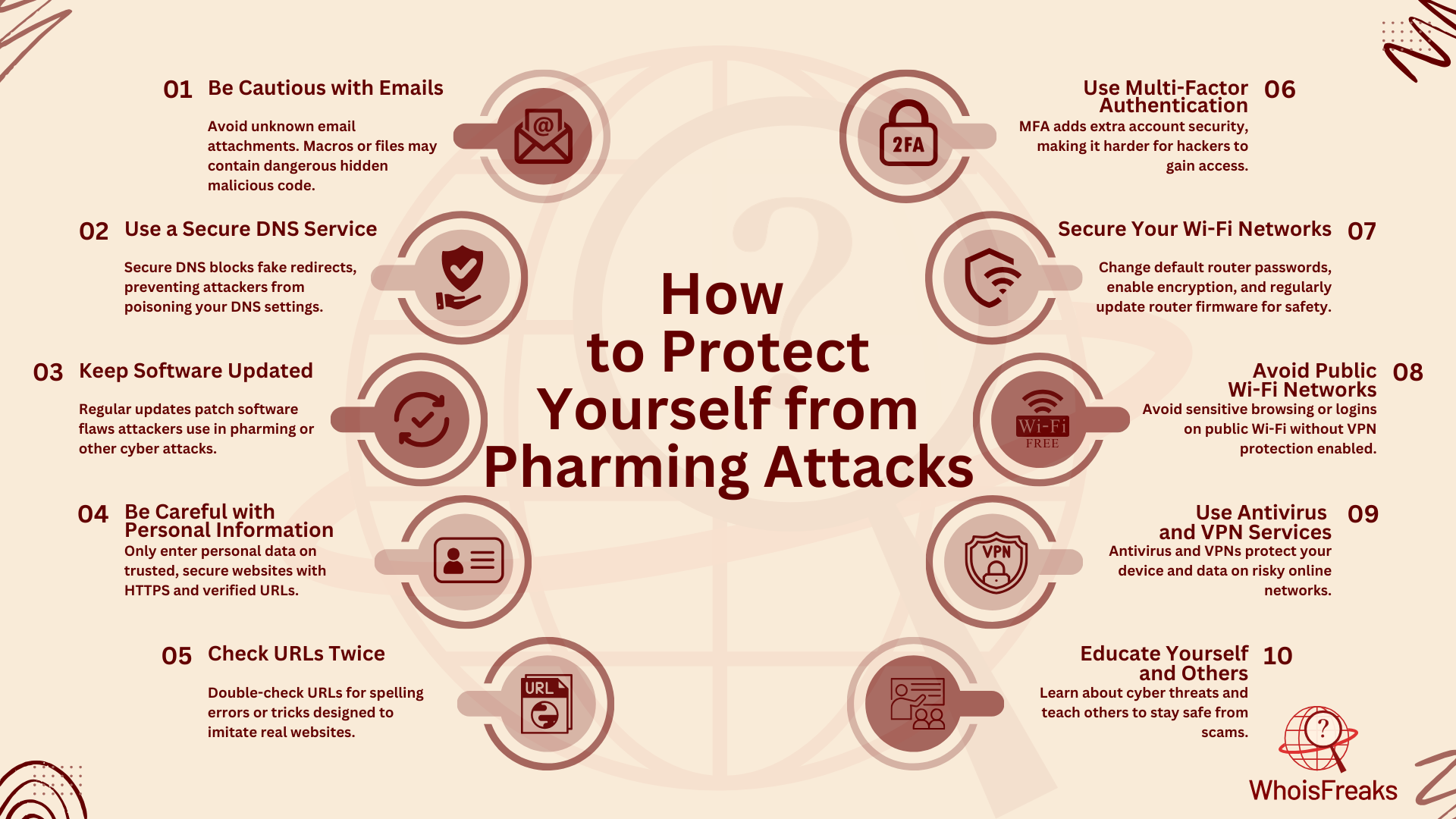
- Be Cautious with Emails: Always be suspicious of emails, especially those with attachments. This includes executable files and files with macros, like Microsoft Word or Excel documents. These files can contain harmful code. Only open attachments from trusted sources, and block macros unless you are sure the file is safe.
- Use a Secure DNS Service: One of the ways pharming attacks works is through DNS server poisoning. To protect against this, use a secure DNS service. This helps keep your devices safe from malicious redirects.
- Keep Software Updated: Pharming attacks often exploit known software vulnerabilities. To prevent them, regularly update your systems and install the latest security patches. Keeping your software current is one of the easiest ways to stay protected.
- Be Careful When Entering Personal Information: Before submitting personal details, like login information or credit card numbers, make sure you're on a legitimate, secure website. Look for HTTPS in the URL to ensure the website is encrypted.
- Check URLs Twice: Double-check website addresses before clicking on links or entering any sensitive data. Ensure the URL matches the official website, and that it begins with HTTPS for added security.
- Use Multi-Factor Authentication: Whenever possible, enable two-factor or multi-factor authentication. This adds an extra layer of protection to your accounts and makes it harder for attackers to access them.
- Secure Your Wi-Fi Networks: If you're using Wi-Fi at home or at the office, change the default admin passwords on your router and enable encryption (like WPA2). Regularly check for updates to your router’s firmware to keep it secure.
- Avoid Public Wi-Fi Networks: Don't connect to random public Wi-Fi networks or unknown hotspots. Even casual browsing on unsecured networks can expose you to risk.
- Use Antivirus and VPN Services: Protect yourself from malware by using trusted antivirus software. A VPN (Virtual Private Network) also helps secure your internet connection and keeps your online activity private.
By following these steps and staying aware of potential risks, you can greatly reduce your chances of falling victim to pharming attacks and protect your personal information.
Famous Pharming Attacks: Real-World Examples of the Risk
Pharming attacks have caused major security issues for both individuals and businesses. Here are a few high-profile pharming attacks that show just how dangerous this kind of cybercrime can be:
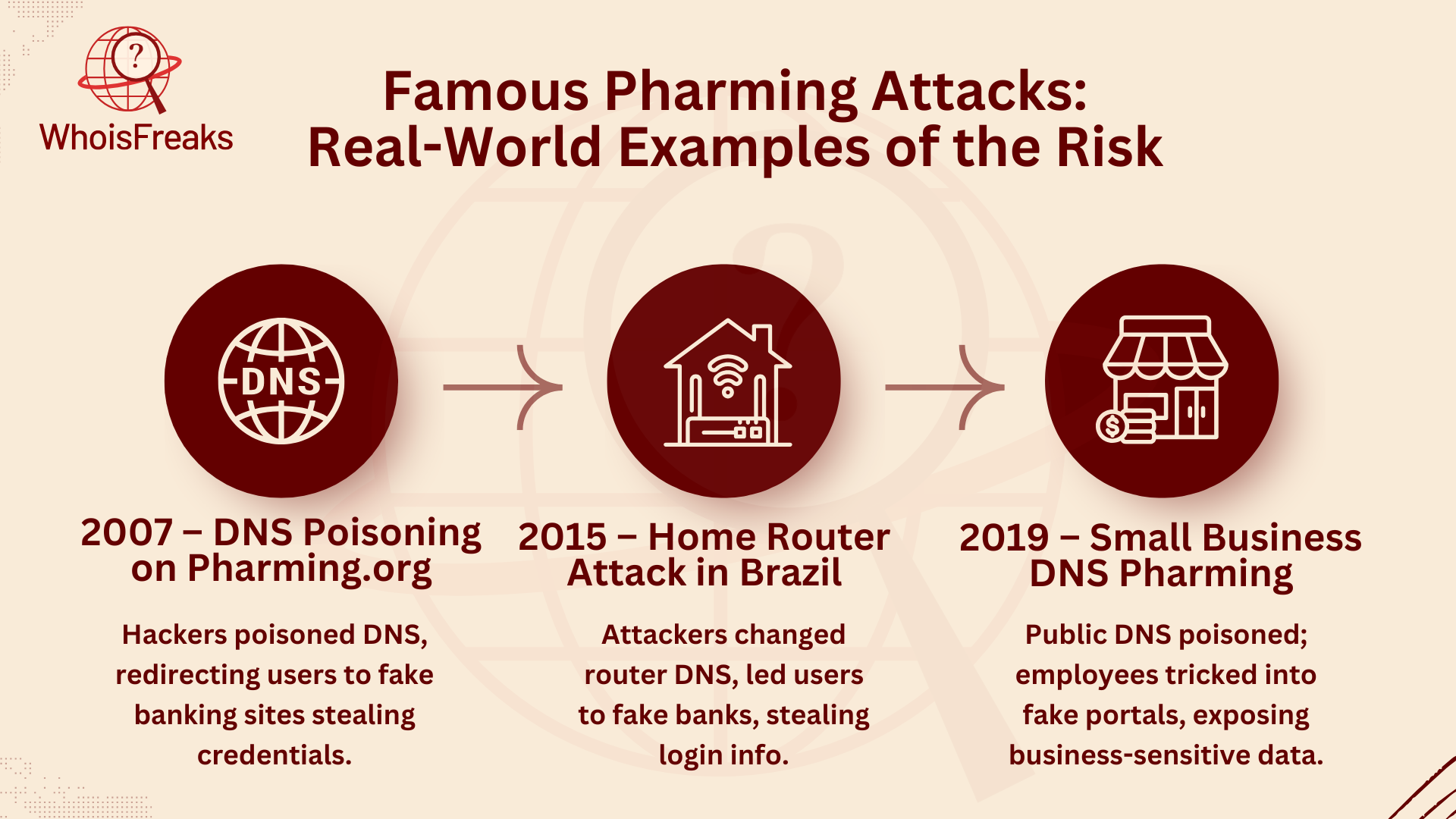
1. The 2007 Pharming Attack on Pharming.org
In 2007, cybercriminals attacked a large group of internet users by poisoning a major DNS server. This caused thousands of users to be automatically redirected to fake banking websites, where their login details were stolen. The attack revealed weaknesses in DNS security, which led to more focus on protecting DNS vulnerabilities.
2. The 2015 DNS Pharming Attack in Brazil
In 2015, attackers in Brazil targeted home routers by changing the DNS settings. This redirection led users to fake versions of popular banking websites. As a result, many victims unknowingly gave away their banking login credentials to hackers. This attack showed how important it is to secure router DNS settings.
3. DNS-Based Pharming in 2019
In 2019, attackers targeted small businesses by poisoning public DNS servers. When employees tried to log in to their company websites or email portals, they were sent to fraudulent versions of those sites. This allowed the attackers to steal login credentials and other sensitive business information. This incident highlighted the damage that DNS-based pharming can cause to companies, no matter their size
Conclusion
Pharming attacks present serious risks to both individuals and businesses, leading to identity theft, financial fraud, data breaches, and reputational damage. These attacks can target sensitive information, such as login credentials and credit card numbers, and redirect users to fake websites without their knowledge. As technology evolves, so do the tactics of cybercriminals. It’s important for both individuals and businesses to stay vigilant and adopt strong security measures, such as using HTTPS, monitoring for unusual traffic, and investing in anti-pharming tools. By staying aware of the signs of pharming and taking proactive steps, we can better protect ourselves and our information from these harmful attacks.
FAQs
1. What is pharming and phishing?
Pharming is when hackers redirect you to fake websites without your knowledge to steal your personal information, like passwords. It happens automatically without needing you to click anything.
Phishing is when cybercriminals trick you into clicking fake links or opening fake emails that ask for your personal info, like usernames and passwords.
2. Where is pharming used?
Pharming is typically used to attack individuals and organizations by redirecting them to fake websites that look real. It's often used to steal sensitive information, such as login credentials, bank account details, or personal data. It can target banks, e-commerce sites, and businesses.
3. What is the difference between spoofing and pharming?
Spoofing is when hackers make something look legitimate, like an email address or website, to trick you into trusting it. For example, they might send an email that appears to be from your bank.
Pharming, on the other hand, redirects you to a fake website automatically, without you clicking anything. It's a more technical attack where malicious code changes your computer’s settings to send you to a fraudulent site, even if you type the correct website address.
4. What are the uses of pharming?
Pharming is primarily used by cybercriminals to steal personal information like usernames, passwords, and financial details. It can also be used to gain unauthorized access to sensitive data, commit fraud, or carry out identity theft. Pharming attacks can target individuals, businesses, and financial institutions to exploit sensitive information for criminal purposes.

Software Engineer
A software engineer focused on developing scalable, efficient solutions. Expertise in coding, system optimization, and utilizing advanced technologies for high-performance apps.
Related Posts

Understanding Domain Fronting: Benefits, Risks, an...
Explore the benefits and risks of domain fronting, its applications, and how it impacts online privacy. Read the article for a comprehensive overview.
Published at: Nov 20, 2025

Essential Strategies to Prevent Subdomain Takeover...
Learn how to prevent subdomain takeover with essential strategies and best practices. Protect your online assets—read the full guide now!
Published at: Nov 18, 2025

Understanding Spear Phishing: Key Insights and Pre...
Learn about spear phishing: its types, risks, and effective prevention strategies to safeguard your digital life. Read more to protect yourself today.
Published at: Nov 10, 2025

Understanding Cache Poisoning: Risks and Preventio...
Learn about cache poisoning risks and effective prevention strategies to safeguard your online presence. Read the article to protect your systems toda...
Published at: Nov 5, 2025